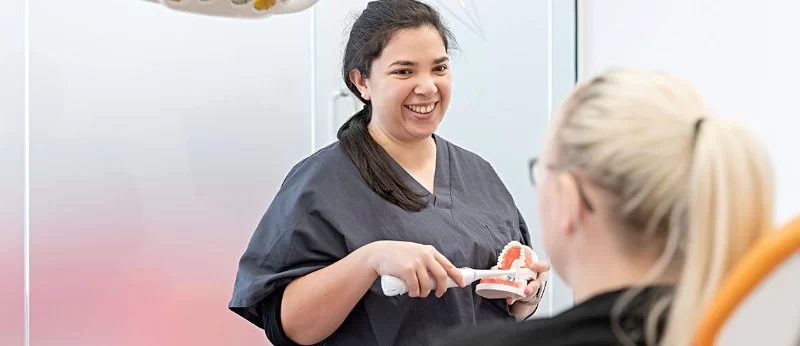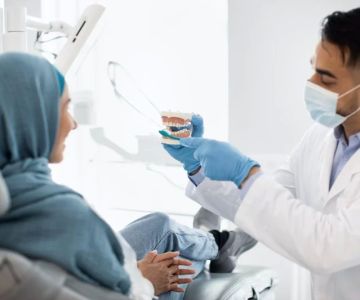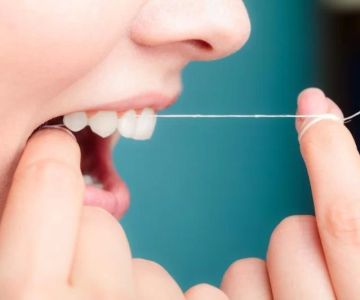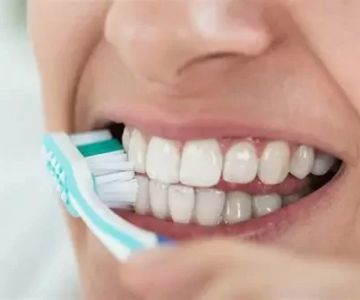
1. What Is Oral Hygiene and Why It Matters
Oral hygiene refers to the practices that keep your mouth clean and healthy, preventing dental issues like cavities, gum disease, and bad breath. While brushing and flossing are often emphasized, good oral hygiene includes everything from regular dental visits to choosing the right diet. For families across the U.S., especially those with young children or aging parents, understanding these fundamentals is essential for lifelong oral health.
1.1 Oral Hygiene Is More Than Brushing
Many people believe brushing twice a day is enough. But oral hygiene is a daily commitment that includes flossing, rinsing with antibacterial mouthwash, tongue cleaning, and even monitoring your breath. These steps ensure that harmful bacteria are minimized, keeping both teeth and gums in top condition.
1.2 A Family in Wisconsin Learns the Hard Way
The Taylor family in Madison, Wisconsin, thought their regular brushing routine was sufficient. However, after their youngest child developed a severe gum infection at just 8 years old, they learned about the importance of flossing and bi-annual dental visits. After adopting a full oral hygiene routine, the family's dental bills dropped by 70% within a year.
2. Common Oral Hygiene Mistakes Most Americans Make
2.1 Ignoring the Gums
One of the biggest mistakes people make is focusing solely on their teeth. In fact, gum health is critical. Gingivitis and periodontitis can silently progress without pain until it's too late. Gently brushing your gums and flossing along the gumline are necessary steps often skipped.
2.2 Overbrushing Can Harm Too
Using a hard-bristled brush and aggressive scrubbing might feel effective, but it can actually erode enamel and irritate gums. Dentists recommend soft-bristle brushes and gentle circular motions to protect your enamel while effectively cleaning your teeth.
2.3 Using Mouthwash Incorrectly
Many people use mouthwash directly after brushing, which can rinse away the protective fluoride left by your toothpaste. Instead, it’s better to use mouthwash at a different time of day, like after lunch, to maintain constant protection.
3. How to Maintain Oral Hygiene Daily
3.1 Start with the Right Tools
High-quality oral hygiene begins with using the right tools: a soft-bristled toothbrush, fluoride toothpaste, waxed dental floss, and an antibacterial mouthwash. Electric toothbrushes are especially effective for those with limited hand mobility or children who struggle with manual brushing.
3.2 Daily Routine That Works
Here's a simple yet effective routine recommended by most American dentists:1. Brush your teeth for two full minutes, twice a day.2. Floss at least once daily.3. Use mouthwash as directed, preferably not right after brushing.4. Replace your toothbrush every 3 months or after illness.5. Drink plenty of water to help cleanse the mouth naturally.
3.3 Creating Habits with Kids
For parents, turning oral hygiene into a fun family activity can make all the difference. One single mom in Phoenix, Arizona, created a “Tooth Hero” chart, where her two kids earned stickers and weekly rewards for completing their brushing and flossing. The result? Not only healthier teeth but also stronger routines that stuck even during vacations.
4. Oral Hygiene Across Different Life Stages
4.1 Infants and Toddlers
Oral hygiene starts before the first tooth. Parents should gently clean their baby’s gums with a soft cloth. Once teeth appear, use a rice-sized smear of fluoride toothpaste and a baby brush to keep them clean.
4.2 Teenagers
Teenagers are prone to neglect due to busy schedules and braces. Encourage routine and offer dental hygiene apps or reminders to help them stay on track. Braces require extra care, including special flossing tools and interdental brushes.
4.3 Adults and Seniors
Adults often juggle responsibilities and may deprioritize oral care. But neglect can lead to irreversible damage. Seniors face added risks like dry mouth and receding gums, making regular checkups and hydration crucial. Dentures, if present, must also be cleaned thoroughly every day.
5. The Science Behind Oral Hygiene and Overall Health
5.1 Connection to Heart Disease and Diabetes
Oral health is not limited to your mouth. Studies from the American Heart Association reveal that gum disease is linked to a higher risk of heart disease. Inflammation from the mouth can enter the bloodstream and affect other parts of the body, including the heart. Diabetics with poor oral hygiene also find it harder to manage blood sugar levels.
5.2 Mental Health and Confidence
There's also a psychological benefit to good oral hygiene. Clean, white teeth contribute to higher self-esteem and confidence. Teenagers and young adults often report improved social experiences after addressing previously untreated dental issues.
6. Where to Find a Trusted Oral Hygiene Guide PDF
6.1 The Need for Printable Guides
Many patients, especially seniors or non-English speakers, benefit from having a simple, illustrated oral hygiene PDF they can refer to at home. These guides usually cover brushing techniques, flossing illustrations, and a dental visit checklist.
6.2 Downloadable Resources for Better Care
You can find a professionally crafted oral hygiene PDF through dental care providers or health education platforms. At Dentistry Toothtruth, we offer free downloadable guides that simplify oral care for all age groups. These PDFs are reviewed by licensed dental hygienists and available in multiple languages for broader accessibility.
6.3 A Patient's Story
James, a 67-year-old retiree from Dallas, struggled with recurring gum infections due to inconsistent hygiene. After receiving a printed PDF from his community clinic, he pinned it on his bathroom mirror. Within six months, his dentist noticed remarkable improvement—less inflammation and zero cavities. Sometimes, clarity and visual aids are the tools we didn’t know we needed.







 Dental Solutions Market Street4.0 (576 review)
Dental Solutions Market Street4.0 (576 review) Mesa Valley Modern Dentistry4.0 (344 review)
Mesa Valley Modern Dentistry4.0 (344 review) Washington Square Dental4.0 (121 review)
Washington Square Dental4.0 (121 review) Gregg W Jepson DMD5.0 (7 review)
Gregg W Jepson DMD5.0 (7 review) Growing Smiles of Voorhees4.0 (2464 review)
Growing Smiles of Voorhees4.0 (2464 review) Metropolitan Endodontics4.0 (78 review)
Metropolitan Endodontics4.0 (78 review) The Importance of Oral Health Education During Pregnancy for a Healthy Pregnancy
The Importance of Oral Health Education During Pregnancy for a Healthy Pregnancy Best Tips for Brushing Your Teeth Properly for Healthy Gums: Essential Techniques for Oral Health
Best Tips for Brushing Your Teeth Properly for Healthy Gums: Essential Techniques for Oral Health Why Skipping Dental Checkups Can Lead to Bigger Oral Health Problems
Why Skipping Dental Checkups Can Lead to Bigger Oral Health Problems Advantages of Porcelain Dental Restorations
Advantages of Porcelain Dental Restorations How Can Diabetes Cause Tooth and Gum Problems? Preventing and Managing Oral Health Issues
How Can Diabetes Cause Tooth and Gum Problems? Preventing and Managing Oral Health Issues Healthy Habits for Promoting Good Oral Health and Hygiene: Tips for a Healthy Smile
Healthy Habits for Promoting Good Oral Health and Hygiene: Tips for a Healthy Smile